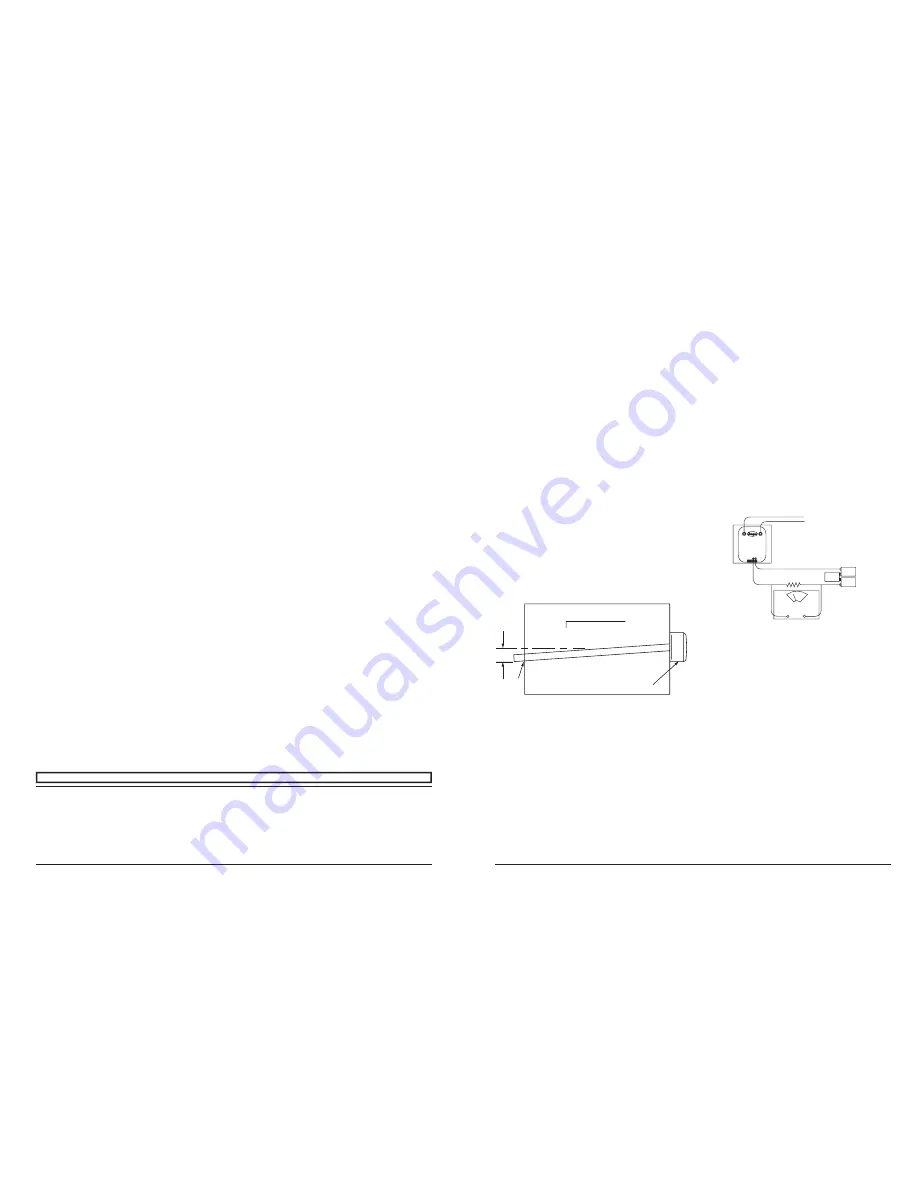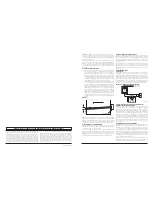
[5.4]REMOTE SAMPLINg TUBE INSTALLATION
The detector arrangement can also incorporate the remote mounting of the
sampling tube and/or exhaust tube. In this case both the detector, sampling
tube and exhaust tube (if included) should be rigidly mounted to withstand
the pressure and vibrations caused by the air velocity. The location of the
detector’s sampling tube should be such that there is uniform airflow in the
cross section area.
Pressure differential across the sampling and exhaust ports in the detector hous-
ing shall be verified to be between 0.01 and 1.11 inches of water. Do so by mea-
suring the pressure difference between the inlet and outlet ports on the detector
housing using a manometer as described in the Measurement Tests sectiont of
this manual.
[6]MEASUREMENT TESTS
[6.1]AIR fLOw
The D355PL is designed to operate over an extended air speed range of 100
to 4000 FPM. To verify sufficient sampling of ducted air, turn the air handler
on and use a manometer to measure the differential pressure between the two
sampling tubes. The differential pressure should measure at least 0.01 inches
of water and no more than 1.11 inches of water. Because most commercially
available manometers cannot accurately measure very low pressure differen-
tials, applications with less than 500 FPM of duct air speed may require one
of the following: 1) the use of a current-sourcing pressure transmitter (Dwyer
Series 607) or 2) the use of aerosol smoke, see below for test descriptions.
[6.2]LOw fLOw AIR fLOw TEST USINg DwyER SERIES 607
DIffERENTIAL PRESSURE TRANSMITTER
Verify the air speed of the duct using an anemometer. Air speed must be at
least 100 FPM. Wire the Dwyer transmitter as shown in
Figure 5
. Connect the
leads of the meter to either side of the 1000
Ω
resistor. Allow unit to warm up
for 15 seconds. With both HIGH and LOW pressure ports open to ambient air,
measure and record the voltage drop across the 1000
Ω
resistor (measurement
1), 4.00 volts is typical. Using flexible tubing and rubber stoppers, connect the
HIGH side of the transmitter to the sampling tube of the duct smoke detec-
tor housing, and the LOW side of the transmitter to the exhaust tube of the
duct smoke detector housing. Measure and record the voltage drop across the
1000
Ω
resistor (measurement 2). Subtract the voltage recorded in measure-
ment 1 from the voltage recorded in measurement 2. If the difference is greater
than 0.15 volts, there is enough air flow through the duct smoke detector for
proper operation.
[7]fIELD wIRINg; INSTALLATION gUIDELINES
All wiring must be installed in compliance with the National Electrical Code
and the local codes having jurisdiction. Proper wire gauges should be used.
The conductors used to connect smoke detectors to control panels and acces-
sory devices should be color-coded to prevent wiring mistakes. Improper con-
nections can prevent a system from responding properly in the event of a fire.
For signal wiring (the wiring between detectors or from detector to auxiliary
devices), it is usually recommended that single conductor wire be no smaller
than 18 gauge. The duct smoke detector terminals accommodate wire sizes up
to 12 gauge. Flexible conduit is recommended for the last foot of conduit; solid
conduit connections may be used if desired.
Duct smoke detectors and alarm system control panels have specifications for
Signaling Line Circuit (SLC) wiring. Consult the control panel manufacturer’s
specifications for wiring requirements before wiring the detector loop.
CAUTION:
The sampling tube end cap, included with the detector, is criti-
cal to proper operation of the duct smoke detector. The end cap is needed to
create the proper air flow to the sensor of the duct smoke detector. Once any
sampling tube length adjustments are made, plug the end of the sampling tube
with the provided end cap.
A plastic exhaust tube is included with the unit to be installed if needed. In-
stall into the housing connection that is downstream from the sampling tube
connection. The exhaust tube can be installed from the front of the detector
or the back. A longer 1 foot exhaust tube, model ETX, is available as an acces-
sory in cases where the molded exhaust tube does not extend at least 2 inches
into the duct.
[5.2]SAMPLINg TUBE INSTALLATION
1. For tubes shorter than the width of the duct, slide the sampling tube,
with installed end cap, into the housing connection that meets the air-
flow first. Position the tube so that the arrow points into the airflow as
shown in Figure 3. Per NFPA sampling tubes over 3 feet long should be
supported at the end opposite of the duct detector. In ducts wider than 8
feet, work must be performed inside the duct to couple the other section
of the sampling tube to the section already installed using the ½-inch
conduit fitting supplied. Make sure that the holes on both sections of the
air inlet sampling tube are lined up and facing into the airflow.
2. For tubes longer than the width of the air duct, the tube should extend
out of the opposite side of the duct. Drill a ¾-inch hole in the duct op-
posite the hole already cut for the sampling tube. Ensure that the sam-
pling tube is angled downward from the duct smoke detector to allow for
moisture drainage away from the detector. The sampling tube should be
angled at least
1
⁄
4
˝ downward for every 12˝ of duct width per Figure 4.
There should be 10 to 12 holes spaced as evenly as possible across the
width of the duct. If there are more than 2 holes in the section of the tube
extending out of the duct, select a shorter tube using Table 1. Otherwise,
trim the tube to leave approximately 1 to 2 inches extending outside the
duct. Plug the end with the end cap and tape closed any holes in the
protruding section of the tube. Be sure to seal the duct where the tube
protrudes.
fIgURE 4.
DETECTOR
3
/
4
˝
HOLE
12˝
1
/
4
˝
2˝
NOTE:
Air currents inside the duct may cause excessive vibration, especially
when the longer sampling tubes are used. In these cases, a 3-inch floor flange
(available at most plumbing supply stores) may be used to fasten the sam-
pling tube to the other side of the duct. When using the flange/connector
mounting technique, drill a 1 to 1¼-inch hole where the flange will be used
[5.3]MODIfICATIONS Of SAMPLINg TUBES
There may be applications where duct widths are not what is specified for the
installation. In such cases, it is permissible to modify a sampling tube that is
longer than necessary to span the duct width.
Use a 0.193-inch diameter (#10) drill and add the appropriate number of holes
so that the total number of holes exposed to the air flow in the duct is 10 to 12.
Space the additional holes as evenly as possible over the length of the tube.
CAUTION:
This procedure should only be used as a temporary fix. It is not
intended as a permanent substitute for ordering the correct length tubes.
FL-300-000
3
I56-3255-003R
HIGH
LOW
9 VOLT
BATTERY
9 VOLT
BATTERY
9 VOLT
BATTERY
TO SAMPLING TUBE
TO EXHAUST TUBE
DIFFERENTIAL
PRESSURE
TRANSMITTER
MODEL #607-01
15 TO 36
VDC SUPPLY
1000 OHM 5%
1 WATT RESISTOR
VOLT METER FLUKE
MODEL 87 OR
EQUIVALENT
+
–
H0163-01
fIgURE 5. PROCEDURE fOR VERIfyINg AIR fLOw:
H0215-00
FL-300-000
6
I56-3255-003R
©
2009 System Sensor
ThREE-yEAR LIMITED wARRANTy
System Sensor warrants its enclosed product to be free from defects in materials and
workmanship under normal use and service for a period of three years from date of
manufacture. System Sensor makes no other express warranty for the enclosed product.
No agent, representative, dealer, or employee of the Company has the authority to in-
crease or alter the obligations or limitations of this Warranty. The Company’s obligation
of this Warranty shall be limited to the replacement of any part of the product which
is found to be defective in materials or workmanship under normal use and service
during the three year period commencing with the date of manufacture. After phoning
System Sensor’s toll free number 800-SENSOR2 (736-7672) for a Return Authorization
number, send defective units postage prepaid to: System Sensor, Returns Department, RA
#__________, 3825 Ohio Avenue, St. Charles, IL 60174. Please include a note describing
the malfunction and suspected cause of failure. The Company shall not be obligated to
replace units which are found to be defective because of damage, unreasonable use,
modifications, or alterations occurring after the date of manufacture. In no case shall the
Company be liable for any consequential or incidental damages for breach of this or any
other Warranty, expressed or implied whatsoever, even if the loss or damage is caused by
the Company’s negligence or fault. Some states do not allow the exclusion or limitation of
incidental or consequential damages, so the above limitation or exclusion may not apply
to you. This Warranty gives you specific legal rights, and you may also have other rights
which vary from state to state.
Please refer to insert for the Limitations of Fire Alarm Systems






















